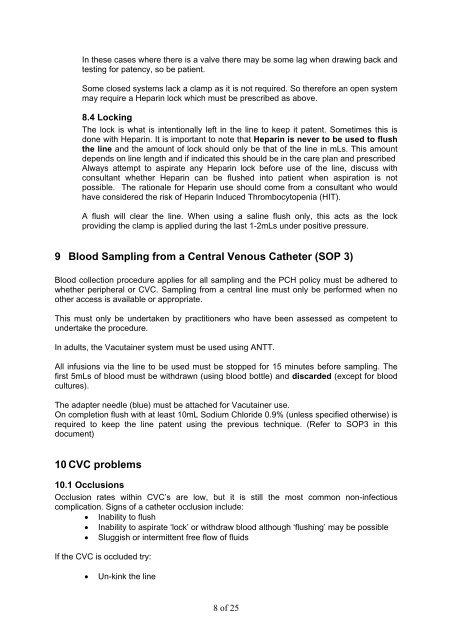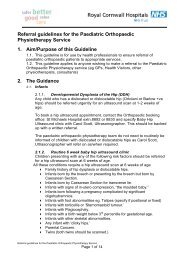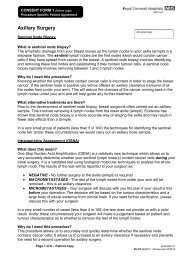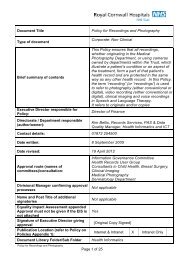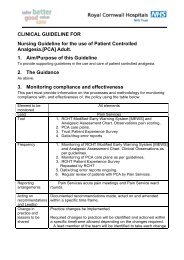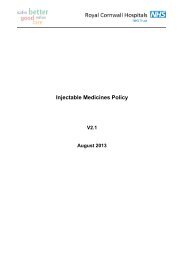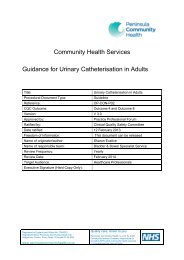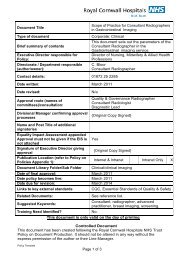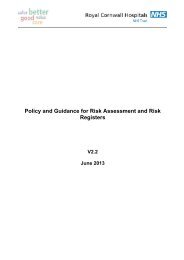(CVC) Management Guidance - the Royal Cornwall Hospitals Trust ...
(CVC) Management Guidance - the Royal Cornwall Hospitals Trust ...
(CVC) Management Guidance - the Royal Cornwall Hospitals Trust ...
Create successful ePaper yourself
Turn your PDF publications into a flip-book with our unique Google optimized e-Paper software.
In <strong>the</strong>se cases where <strong>the</strong>re is a valve <strong>the</strong>re may be some lag when drawing back and<br />
testing for patency, so be patient.<br />
Some closed systems lack a clamp as it is not required. So <strong>the</strong>refore an open system<br />
may require a Heparin lock which must be prescribed as above.<br />
8.4 Locking<br />
The lock is what is intentionally left in <strong>the</strong> line to keep it patent. Sometimes this is<br />
done with Heparin. It is important to note that Heparin is never to be used to flush<br />
<strong>the</strong> line and <strong>the</strong> amount of lock should only be that of <strong>the</strong> line in mLs. This amount<br />
depends on line length and if indicated this should be in <strong>the</strong> care plan and prescribed<br />
Always attempt to aspirate any Heparin lock before use of <strong>the</strong> line, discuss with<br />
consultant whe<strong>the</strong>r Heparin can be flushed into patient when aspiration is not<br />
possible. The rationale for Heparin use should come from a consultant who would<br />
have considered <strong>the</strong> risk of Heparin Induced Thrombocytopenia (HIT).<br />
A flush will clear <strong>the</strong> line. When using a saline flush only, this acts as <strong>the</strong> lock<br />
providing <strong>the</strong> clamp is applied during <strong>the</strong> last 1-2mLs under positive pressure.<br />
9 Blood Sampling from a Central Venous Ca<strong>the</strong>ter (SOP 3)<br />
Blood collection procedure applies for all sampling and <strong>the</strong> PCH policy must be adhered to<br />
whe<strong>the</strong>r peripheral or <strong>CVC</strong>. Sampling from a central line must only be performed when no<br />
o<strong>the</strong>r access is available or appropriate.<br />
This must only be undertaken by practitioners who have been assessed as competent to<br />
undertake <strong>the</strong> procedure.<br />
In adults, <strong>the</strong> Vacutainer system must be used using ANTT.<br />
All infusions via <strong>the</strong> line to be used must be stopped for 15 minutes before sampling. The<br />
first 5mLs of blood must be withdrawn (using blood bottle) and discarded (except for blood<br />
cultures).<br />
The adapter needle (blue) must be attached for Vacutainer use.<br />
On completion flush with at least 10mL Sodium Chloride 0.9% (unless specified o<strong>the</strong>rwise) is<br />
required to keep <strong>the</strong> line patent using <strong>the</strong> previous technique. (Refer to SOP3 in this<br />
document)<br />
10 <strong>CVC</strong> problems<br />
10.1 Occlusions<br />
Occlusion rates within <strong>CVC</strong>’s are low, but it is still <strong>the</strong> most common non-infectious<br />
complication. Signs of a ca<strong>the</strong>ter occlusion include:<br />
Inability to flush<br />
Inability to aspirate ‘lock’ or withdraw blood although ‘flushing’ may be possible<br />
Sluggish or intermittent free flow of fluids<br />
If <strong>the</strong> <strong>CVC</strong> is occluded try:<br />
<br />
Un-kink <strong>the</strong> line<br />
8 of 25


